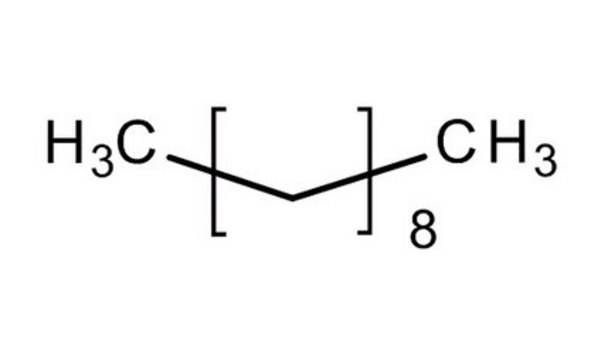About This Item
Recommended Products
grade
analytical standard
Quality Level
vapor density
4.9 (vs air)
vapor pressure
1 mmHg ( 16.5 °C)
3.77 mmHg ( 37.7 °C)
CofA
current certificate can be downloaded
autoignition temp.
410 °F
expl. lim.
2.6 %
packaging
ampule of 1000 mg
technique(s)
HPLC: suitable
gas chromatography (GC): suitable
refractive index
n20/D 1.411 (lit.)
bp
174 °C (lit.)
mp
−30 °C (lit.)
density
0.73 g/mL at 25 °C (lit.)
application(s)
environmental
petroleum
format
neat
storage temp.
2-30°C
SMILES string
CCCCCCCCCC
InChI
1S/C10H22/c1-3-5-7-9-10-8-6-4-2/h3-10H2,1-2H3
InChI key
DIOQZVSQGTUSAI-UHFFFAOYSA-N
Looking for similar products? Visit Product Comparison Guide
General description
Application
It may be used as an extraction solvent of headspace single-drop microextraction (HS-SDME) with droplet derivatization for the determination of hexanal and heptanal in human blood by GC-MS.
Signal Word
Danger
Hazard Statements
Precautionary Statements
Hazard Classifications
Asp. Tox. 1 - Flam. Liq. 3
Supplementary Hazards
Storage Class Code
3 - Flammable liquids
WGK
WGK 1
Flash Point(F)
114.8 °F - closed cup
Flash Point(C)
46.0 °C - closed cup
Personal Protective Equipment
Regulatory Information
Choose from one of the most recent versions:
Already Own This Product?
Find documentation for the products that you have recently purchased in the Document Library.
Protocols
Separation of Decane; Dodecane; Tetradecane; Hexadecane; Octadecane; Eicosane; Docosane; Tetracosane; Hexacosane; Octacosane
Our team of scientists has experience in all areas of research including Life Science, Material Science, Chemical Synthesis, Chromatography, Analytical and many others.
Contact Technical Service






